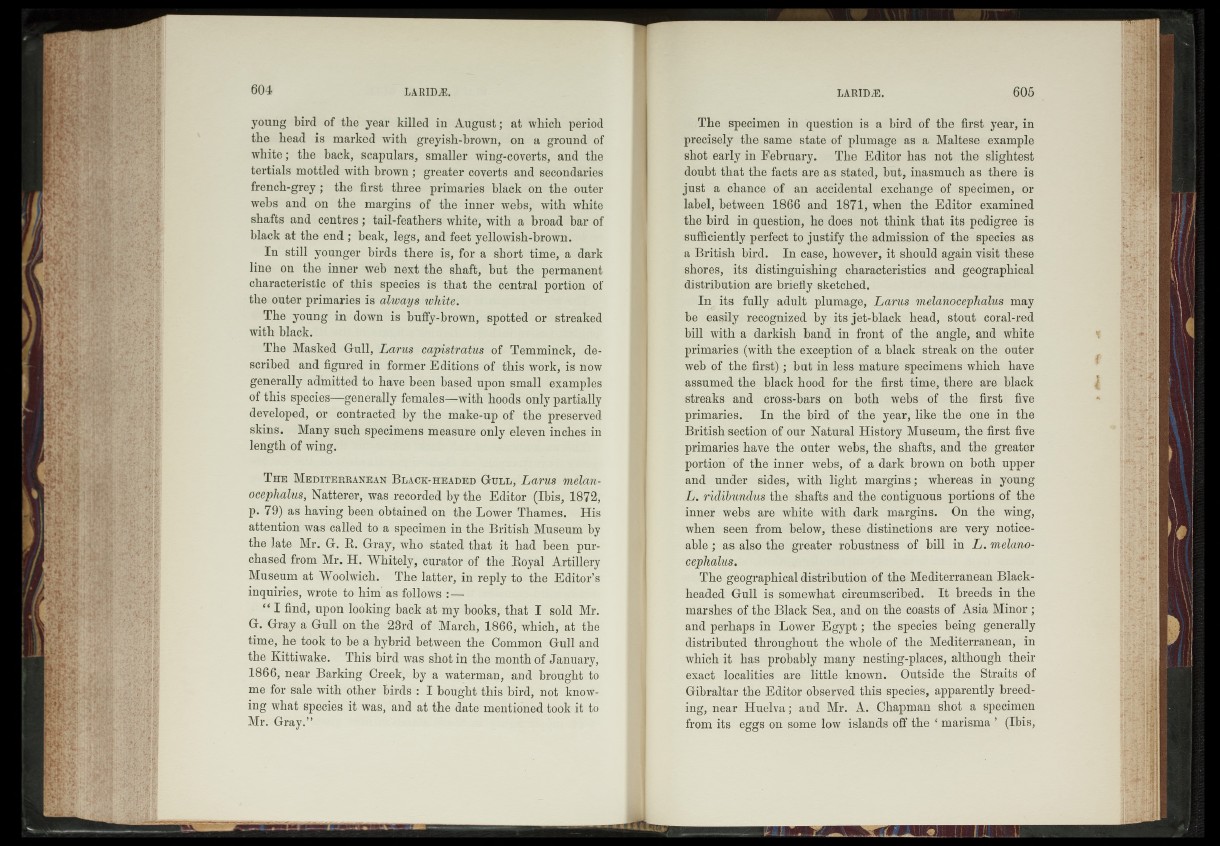
young bird of the year killed in August ; at which period
the head is marked with greyish-brown, on a ground of
white; the back, scapulars, smaller wing-coverts, and the
tertials mottled with brown ; greater coverts and secondaries
french-grey; the first three primaries black on the outer
webs and on the margins of the inner webs;* with white
shafts and. centres; tail-feathers white; with a broad bar of
black at the end; beak, legs, and feet yellowish-brown.
In still younger birds there is, for a short time, a dark
line on the inner web next the shaft, but the permanent
characteristic of this species is that the central portion of
the outer primaries is always white.' -
The young in down is huffy-brown, spotted or streaked
with black.
The Masked Gull, La/rus capistratus of- Temminck, described
and figured in former Editions of this work, is now
generally adtnitted to have been based upon small examples
of this species-^-generally females"—withhoods only partially
developed, or contracted by the make-up of the preserved
skins. Many such specimens measure only eleven inches in
length of wing.
T h e M ed it e r r a n ea n B lack-h e a d e d G u l l , Larus melan-
acephalusyNa.tterer, was recorded by the Editor (Ibis, 1872,
p. 79) as having been obtained on the Lower Thames. His
attention was called to a specimen in /the* British Museum by
the late Mr. G. R. Gray, who stated-Jhat- -it-had been purchased
from Mr. H. Whitelyyourator of the 'Royal Artillery
Museum at Woolwich. The latter, in reply ttlfcthe Editor’s
inquiries, wrote to him' as follows :^--.
“ I find, upon looking back at my books,, that I sold' Mr.
G. Gray a Gull on the 23rd of March, l*866#which, at the
time, he took to be#hybrid between the* Common Gull and
the Kittiwake. This bird was shot in the month of January,
1866, near Barking Ciei§£;t by a waterman, and brought to
me for sale with other Birds : I -boug-ht -this bird, not knowing
what species if 'was, and at the date mentionedioohit. to
Mr. Gray.”
The specimen in question is a bird of the first year, in
precisely the same state of plumage as a Maltese example
shot early in February. The Editor has not the slightest
doubt that the facts are as stated, but, inasmuch as there is
just a chance of an accidental exchange of specimen, or
label* between 1866 and 1871, when the Editor examined
the bird in question, he-does not think that its pedigree is
sufficiently perfect to justify the admission of the species as
a British bird. In case, however, it should again visit these
shores, its distinguishing characteristics and geographical
distribution are briefly sketched.
In its fully adult plumage, Larus melanocephalus, may
be easily -recognized by its -jet-black head, stout coral-red
bill with a darkish band in front of the angle, and white
primaries (with the exception .of a black streak on the outer
web of the first); but indess mature specimens, which .have
assumed the .black hood for the first time, there are black
streaks and cross-bars on both webs - of the first five
primaries. - din dhe bird of* the: year, like the one in the
British section of our Natural History Museum, the first five
primaries have the outer webs, the- shafts, and the greater
portion of thAln-ner, webs, of a dark brown on both upper
and under sides, with - light margins; whereas in young
L. Hdibund/ustthe; shafts and the contiguous portions of the
inner webs are*, white with dark margins. On the wing,
when seen, from below, -these- distinctions are very .notieer
-able.; as also the .greater, robustness of bill in L . melanor
yeephhluS‘.i>
The geographical distribution of the Mediterranean Black-
headed GiM isl somewhat- circumscribed; It breeds, in the
marshes of the Black: Sea, .and on the coasts of Asia-Minor;
and perhaps in-Lower-Egypt; the species** being generally
distributed throughout the whole ©f the Mediterranean, in
which it has probably many -nesting-places, although their
exact localities - areUMttles.- known. Outside--the Straits of
Gibraltar the Editor1 observed this species, apparently breeding,
near HueJva.f- and Mr. A. Chapman sbgfc. a specimen
from its eggs on some low islands off the ‘ marisma ’ (Ibis,